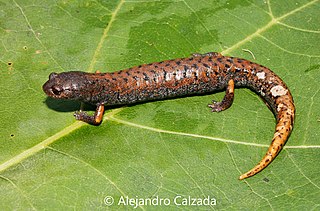Ixalotriton niger, the black jumping salamander, is a species of salamander in the family Plethodontidae. It is endemic to Mexico. Its natural habitats are subtropical or tropical moist montane forests and rocky areas and it is threatened by habitat loss.
Ixalotriton parva, the dwarf false brook salamander, is a species of salamander in the family Plethodontidae. It is endemic to a small mountainous area of Mexico where its natural habitat is subtropical or tropical moist montane forests. It is threatened by habitat loss. There is some doubt whether this species should be classified as Pseudoeurycea parva or Ixalotriton parva.
Pseudoeurycea orchileucos, commonly known as the Sierra de Juárez worm salamander, is a species of salamander in the family Plethodontidae. It is endemic to Oaxaca, Mexico, where it is known from the northern slopes of Sierra de Juarez at elevations of 800–1,390 m (2,620–4,560 ft) above sea level.
Parvimolge is a genus of salamanders in the family Plethodontidae, the lungless salamanders. It is currently considered as monotypic, although this may yet change as molecular data suggest that it is embedded within a paraphyletic Pseudoeurycea. Parvimolge townsendi is endemic to the Sierra Madre Oriental in central and southern Veracruz, Mexico. It is represented by the species Parvimolge townsendi, commonly known as Townsend's dwarf salamander.

The Caddo Mountain salamander is a species of salamander in the family Plethodontidae endemic to Arkansas in the south-central United States, and only known from the Caddo Mountains, a part of the Ouachita Mountains.

Pseudoeurycea is a genus of salamander in the family Plethodontidae. The members of this genus are commonly known as the false brook salamanders. They are found in Mexico and Guatemala.
Pseudoeurycea amuzga, which has been given the common name of Sierra de Malinaltepec salamander, is a species of salamander in the family Plethodontidae. It is endemic to Mexico and known only from Sierra de Malinaltepec, a part of Sierra Madre del Sur in the Guerrero state.
Pseudoeurycea anitae, commonly known as Anita's false brook salamander or Anita's salamander, is a species of salamander in the family Plethodontidae. It is endemic to Mexico and only known from its type locality near San Vicente Lachixío, Oaxaca, in the Sierra Madre del Sur mountains, at about 2,100 m (6,900 ft) above sea level. The specific name anitae honors Anita Smith, a resident of Oaxaca City who helped Charles Mitchill Bogert when he was collecting in the surroundings of the city. This species might already be extinct.
Pseudoeurycea lynchi, commonly known as the Veracruz green salamander, is a species of salamanders in the family Plethodontidae. It is endemic to the central Sierra Madre Oriental in Veracruz and Puebla states, Mexico.
Pseudoeurycea melanomolga, commonly known as the black false brook salamander or black salamander, is a species of salamander in the family Plethodontidae. It is endemic to Mexico and known from the surroundings of the Cofre de Perote in west-central Veracruz as well as from two localities in the adjacent northeast Puebla.

Pseudoeurycea mystax is a species of salamander in the family Plethodontidae. It is endemic to Mexico and only known from the area of its type locality near Ayutla, Oaxaca. Its common name is mustache false brook salamander or mustached false brook salamander. The specific name refers to the whitish protuberances on the lips that resemble a mustache in the frontal view of the male holotype.
Isthmura naucampatepetl, commonly known as the Cofre de Perote salamander, is a species of salamanders in the family Plethodontidae. It is endemic to the Sierra Madre Oriental in central Veracruz, Mexico, where it is known from between Cofre de Perote and Cerro Volcancillo, a satellite peak of Cofre de Perote.
Pseudoeurycea nigromaculata, commonly known as the black-spotted salamander or black-spotted false brook salamander is a species of salamander in the family Plethodontidae. It is endemic to Veracruz, Mexico, and known from Cerro Chicahuaxtla ) in Cuatlalpan and from Volcán San Martín at elevations of 1,200–1,300 m (3,900–4,300 ft). These separate populations likely represent distinct species.
The ridge tail salamander, also known as ridge-tailed salamander is a species of salamander in the family Plethodontidae. It is endemic to Oaxaca, Mexico, and only known from the area of its type locality.
Aquiloeurycea praecellens, also known as the admirable false brook salamander, is a species of salamander in the family Plethodontidae. It is endemic to the Sierra Madre Oriental in Veracruz, Mexico. Its natural habitat is lowland tropical moist forest where it is threatened by habitat loss.
Pseudoeurycea robertsi is a species of salamander in the family Plethodontidae. It is endemic to Mexico and only known from the Nevado de Toluca, near Toluca in the State of Mexico. Its common name is Roberts' false brook salamander. The specific name robertsi honors the collector of the holotype, H. Radclyffe Roberts from the Philadelphia Academy of Sciences.
Pseudoeurycea saltator is a species of salamander in the family Plethodontidae. It is endemic to Oaxaca, Mexico, and only known from the northern slopes of the Sierra de Juarez above Vista Hermosa.
Pseudoeurycea smithi, commonly known as Smith's false brook salamander, is a species of salamander in the family Plethodontidae. It is endemic to certain mountainous regions of Mexico. Its natural habitat is subtropical or tropical moist montane forests. It is threatened by habitat loss.
Pseudoeurycea unguidentis is a species of salamander in the family Plethodontidae. It is endemic to northern Oaxaca, Mexico, where it is known from its type locality, Cerro San Felipe, and some other mountains, although the identity of animals from these other locations is uncertain. Its common names are claw-toothed salamander, clawtooth false brook salamander, and clawtoed false brook salamander.


